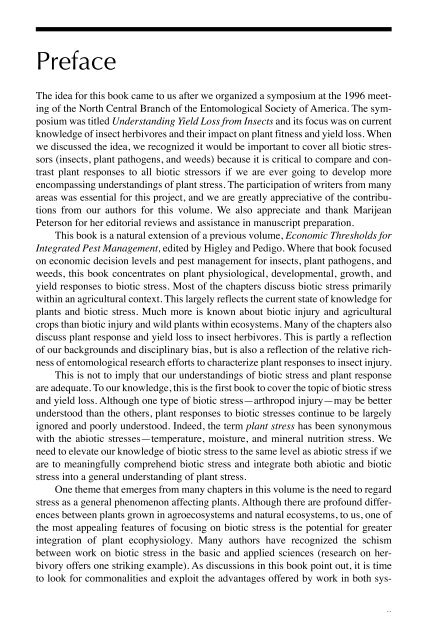Biotic Stress and Yield Loss
Biotic Stress and Yield Loss
Biotic Stress and Yield Loss
- No tags were found...
Create successful ePaper yourself
Turn your PDF publications into a flip-book with our unique Google optimized e-Paper software.
PrefaceThe idea for this book came to us after we organized a symposium at the 1996 meetingof the North Central Branch of the Entomological Society of America. The symposiumwas titled Underst<strong>and</strong>ing <strong>Yield</strong> <strong>Loss</strong> from Insects <strong>and</strong> its focus was on currentknowledge of insect herbivores <strong>and</strong> their impact on plant fitness <strong>and</strong> yield loss. Whenwe discussed the idea, we recognized it would be important to cover all biotic stressors(insects, plant pathogens, <strong>and</strong> weeds) because it is critical to compare <strong>and</strong> contrastplant responses to all biotic stressors if we are ever going to develop moreencompassing underst<strong>and</strong>ings of plant stress. The participation of writers from manyareas was essential for this project, <strong>and</strong> we are greatly appreciative of the contributionsfrom our authors for this volume. We also appreciate <strong>and</strong> thank MarijeanPeterson for her editorial reviews <strong>and</strong> assistance in manuscript preparation.This book is a natural extension of a previous volume, Economic Thresholds forIntegrated Pest Management, edited by Higley <strong>and</strong> Pedigo. Where that book focusedon economic decision levels <strong>and</strong> pest management for insects, plant pathogens, <strong>and</strong>weeds, this book concentrates on plant physiological, developmental, growth, <strong>and</strong>yield responses to biotic stress. Most of the chapters discuss biotic stress primarilywithin an agricultural context. This largely reflects the current state of knowledge forplants <strong>and</strong> biotic stress. Much more is known about biotic injury <strong>and</strong> agriculturalcrops than biotic injury <strong>and</strong> wild plants within ecosystems. Many of the chapters alsodiscuss plant response <strong>and</strong> yield loss to insect herbivores. This is partly a reflectionof our backgrounds <strong>and</strong> disciplinary bias, but is also a reflection of the relative richnessof entomological research efforts to characterize plant responses to insect injury.This is not to imply that our underst<strong>and</strong>ings of biotic stress <strong>and</strong> plant responseare adequate. To our knowledge, this is the first book to cover the topic of biotic stress<strong>and</strong> yield loss. Although one type of biotic stress—arthropod injury—may be betterunderstood than the others, plant responses to biotic stresses continue to be largelyignored <strong>and</strong> poorly understood. Indeed, the term plant stress has been synonymouswith the abiotic stresses—temperature, moisture, <strong>and</strong> mineral nutrition stress. Weneed to elevate our knowledge of biotic stress to the same level as abiotic stress if weare to meaningfully comprehend biotic stress <strong>and</strong> integrate both abiotic <strong>and</strong> bioticstress into a general underst<strong>and</strong>ing of plant stress.One theme that emerges from many chapters in this volume is the need to regardstress as a general phenomenon affecting plants. Although there are profound differencesbetween plants grown in agroecosystems <strong>and</strong> natural ecosystems, to us, one ofthe most appealing features of focusing on biotic stress is the potential for greaterintegration of plant ecophysiology. Many authors have recognized the schismbetween work on biotic stress in the basic <strong>and</strong> applied sciences (research on herbivoryoffers one striking example). As discussions in this book point out, it is timeto look for commonalities <strong>and</strong> exploit the advantages offered by work in both sys-vii

















